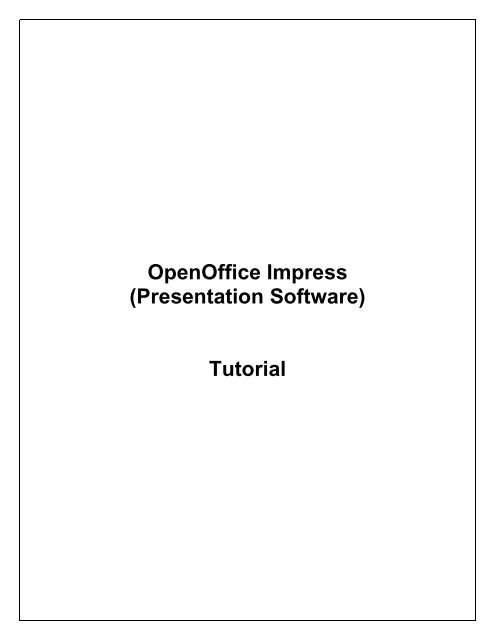Openoffice Impress (Presentation Software) Tutorial
Openoffice Impress (Presentation Software) Tutorial
Openoffice Impress (Presentation Software) Tutorial
Create successful ePaper yourself
Turn your PDF publications into a flip-book with our unique Google optimized e-Paper software.
OpenOffice <strong>Impress</strong><br />
(<strong>Presentation</strong> <strong>Software</strong>)<br />
<strong>Tutorial</strong>
Table of Contents<br />
Introduction ...........................................................................................................3<br />
Starting OpenOffice <strong>Impress</strong>.................................................................................3<br />
Looking at the Screen ...........................................................................................4<br />
Creating an Empty (Blank) <strong>Presentation</strong>...............................................................5<br />
Adding Information to a Slide................................................................................6<br />
Opening and Saving a <strong>Presentation</strong> .....................................................................6<br />
Opening a <strong>Presentation</strong>.....................................................................................6<br />
Saving a <strong>Presentation</strong> .......................................................................................7<br />
Adding New Slides................................................................................................8<br />
Formatting Text on a Slide....................................................................................9<br />
Changing the Font/Font Size.............................................................................9<br />
Bold, Italics, Underline.......................................................................................9<br />
Paragraph Alignment.........................................................................................9<br />
Adding Bullets and Numbering..........................................................................9<br />
Cut, Copy, Paste.................................................................................................10<br />
Cut and Paste..................................................................................................10<br />
Copy and Paste...............................................................................................10<br />
Adding Pictures...................................................................................................10<br />
Creating a Table .................................................................................................11<br />
Deleting a Slide(s)...............................................................................................11<br />
Views Bar............................................................................................................12<br />
Formatting a Slide...............................................................................................12<br />
Modifying Slide Layout ....................................................................................12<br />
Adding a Background Color/Image..................................................................13<br />
Adding Effects (Animation) .................................................................................13<br />
Example: Adding Effects .................................................................................14<br />
Adding/Changing Slide Transition.......................................................................15<br />
Printing a <strong>Presentation</strong>........................................................................................17
Introduction<br />
OpenOffice is an open source Office Suite package originally designed by Sun<br />
Microsystems. OpenOffice is much like Microsoft Office but free to use. The<br />
software can be freely downloaded and used.<br />
OpenOffice <strong>Impress</strong> is much like using Microsoft PowerPoint.<br />
Starting OpenOffice <strong>Impress</strong><br />
Procedure<br />
1. Click Start, Programs, OpenOffice.org 1.0.3.<br />
3
Menu Bar<br />
Looking at the Screen<br />
<strong>Presentation</strong> Window<br />
Main Toolbar<br />
Slide Navigation, Slide Title buttons<br />
There are five visible bars:<br />
• The Menu Bar that lists commands in a menu style,<br />
• The Function Bar that includes icons for common actions: open, save,<br />
copy, cut, paste, etc.,<br />
• The Command Bar with icons for formatting the text,<br />
• The Main Toolbar, with specific tools used during the typing phase to<br />
insert fields, forms, images, and other objects,<br />
• The Status Bar that displays information: the current page, current<br />
template, zoom percentage, insert or overwrite mode, selection mode, and<br />
hyperlink mode;<br />
As well as two floating windows:<br />
• The Stylist. Used to change the style of the text with few clicks,<br />
• The Navigator. This tool is particularly useful in long documents with<br />
many chapters, sections, images, etc.<br />
If the floating windows are not displayed by default, you can display them by<br />
clicking on the Navigator icon<br />
function bar.<br />
and the Stylist icon that you find on the<br />
4<br />
Function Toolbar<br />
Object Toolbar (The<br />
buttons will change<br />
depending on what you<br />
have selected)<br />
<strong>Presentation</strong><br />
Styles window
Creating an Empty (Blank) <strong>Presentation</strong><br />
When you start OpenOffice <strong>Impress</strong>, you will first see the following window. You<br />
have the option of creating an empty (blank) presentation; a presentation from a<br />
Template or you can open an existing presentation.<br />
Procedures<br />
1. Click Empty presentation.<br />
2. Click the Next button.<br />
3. Select how the presentation will be presented (output medium) (e.g.<br />
screen).<br />
4. Click the Next button.<br />
5. Select a slide transition effect and speed (optional). This can be<br />
changed later (See section: Adding a Slide Transition).<br />
6. Select a presentation type:<br />
a. Default - each slide will advance with a mouse click.<br />
b. Automatic – choose the duration of each page.<br />
7. Click the Create button.<br />
8. The Modify Slide window will appear.<br />
5<br />
Title, Spreadsheet<br />
auto layout
9. Type a name for your slide (optional) or use the default name (e.g. Slide<br />
1).<br />
10. Select an Auto Layout (e.g. Title Slide). Use an auto layout that is<br />
representative of the data you wish to present. For example, if you want a<br />
slide with a title and a table, use the Title, Spreadsheet auto layout.<br />
11. Click the OK button.<br />
Adding Information to a Slide<br />
Procedures<br />
1. A blank slide will now appear.<br />
2. Enter text by clicking where indicated.<br />
3. A gray border will appear.<br />
4. To indent (demote) text, click the Demote button on the toolbar.<br />
5. To promote text, click the Promote button on the toolbar.<br />
Opening and Saving a <strong>Presentation</strong><br />
Opening a <strong>Presentation</strong><br />
Procedures<br />
From the following window<br />
1. Select Open existing presentation.<br />
2. From the list, choose the filename of the file you want to open.<br />
3. Click the Create button.<br />
4. If the filename does not appear in the list, click .<br />
6
5. Click the Create button.<br />
6. An Open dialogue box will appear. Locate the filename you wish to open<br />
and double click on it.<br />
Saving a <strong>Presentation</strong><br />
Remember to save your work often so there is no chance of losing it.<br />
Procedures<br />
1. Choose File, Save from the menu bar, OR<br />
2. Click the Save icon on the toolbar.<br />
3. If you are saving for the first time, a Save File Dialog Window will be<br />
displayed.<br />
4. Type a filename and choose a location to save the file.<br />
5. If you wish to save your file as a Microsoft PowerPoint file format, change<br />
the Save as type to Microsoft PowerPoint 97/2000/XP.<br />
7
6. Click the Save button.<br />
Adding New Slides<br />
Procedures<br />
1. From the <strong>Presentation</strong> window, click Insert Slide…<br />
2. Type a Title for the slide (e.g. Title, Text).<br />
3. Select an AutoLayout.<br />
4. Click the OK button.<br />
Note: All slides in your presentation will be listed at the bottom of the screen.<br />
8
Formatting Text on a Slide<br />
Changing the Font/Font Size<br />
Font is the style of writing and font size is the size of the text with a 12-point size<br />
being 1/6 of an inch.<br />
Procedures<br />
1. Select the text you wish to change.<br />
2. On the toolbar, click the first drop-down arrow to<br />
change the font and the second drop down arrow to change the font size.<br />
Bold, Italics, Underline<br />
Procedures<br />
1. Select the text you wish to format.<br />
2. Click on the attribute icon you wish to apply such as on the<br />
Toolbar. These buttons transform the selected text (in sequence from left to<br />
right) into Bold, Italics, and Underlined.<br />
3. With the text still selected, click the button again to turn the feature off.<br />
Paragraph Alignment<br />
Procedures<br />
1. Select the paragraph you wish to change.<br />
2. Click on one of the alignment icons on the function toolbar to<br />
modify the text alignment (left, center, right, or justified).<br />
Adding Bullets and Numbering<br />
Procedures<br />
1. Select the text for which you wish to add bullets/numbering.<br />
2. Click bullets button or numbering button on the object toolbar<br />
depending on what you want.<br />
9
Cut, Copy, Paste<br />
You can perform four main actions on a selected text: copying, cutting, deleting,<br />
and formatting.<br />
Cut and Paste<br />
This allows the user to move selected text so that it can be placed somewhere<br />
else in the document or in another document.<br />
Procedures<br />
1. Select text you wish to cut (move).<br />
2. Click the Cut button on the toolbar or CTRL + X on the keyboard.<br />
3. Place the cursor where to place the cut text.<br />
4. Click the Paste button on the toolbar or CTRL + V on the keyboard.<br />
Copy and Paste<br />
This allows the user to create a duplicate (copy) of the selected text to be placed<br />
somewhere else in the document or in another document.<br />
Procedures<br />
1. Select text you wish to copy.<br />
2. Click the Copy button on the toolbar or CTRL + C on the keyboard.<br />
3. Place the cursor where to place the cut text.<br />
4. Click the Paste button on the toolbar or CTRL + V on the keyboard.<br />
Adding Pictures<br />
Procedures<br />
1. Place your cursor where you want to place a picture.<br />
2. Click Insert menu, Click Graphics.<br />
10
3. Pick the location where the file has been saved.<br />
4. Double click filename to insert into document.<br />
Note: Use the following toolbar to modify picture attributes such as color,<br />
contrast, and brightness.<br />
Creating a Table<br />
Tables allow the user to arrange data in a series of rows and columns.<br />
Procedures<br />
1. Insert a new slide using the Title, Spreadsheet AutoLayout.<br />
2. Where indicated, double click to add a spreadsheet (table). A spreadsheet<br />
will appear.<br />
3. Fill in your information. (See OpenOffice Calc tutorial for more<br />
information)<br />
4. Format the data in the spreadsheet.<br />
5. Click on slide away from the spreadsheet you have just created.<br />
6. If at any time you wish to edit the data in the spreadsheet, double click on<br />
the table in your slide.<br />
Deleting a Slide(s)<br />
Procedures<br />
1. Right click on Slide name at the bottom of the screen.<br />
2. Left click Delete Slide…<br />
3. You will be asked if you want to delete the slide.<br />
4. Click Yes or No depending on what you want to do.<br />
11
Views Bar<br />
Drawing View<br />
� Drawing view is the most common view which allows you to type<br />
information and add pictures and drawing objects right on the slide.<br />
Outline View<br />
� Outline view allows you to create your slides from an outline rather<br />
than entering information directly on a slide.<br />
Slide View<br />
� Slide view allows you to rearrange slides by clicking and dragging the<br />
slide to the new location. This view also allows you to add slide<br />
transitions to multiple slides at once.<br />
Notes View<br />
� In Notes View you can add notes to each slide so that these notes can<br />
be printed along with the slide when giving a presentation.<br />
Handout View<br />
� Handout view shows how many slides would be printed on a page.<br />
Each slide in this view can be moved by clicking and dragging the<br />
slide.<br />
Slide Show View<br />
� Use Slide Show View to give your presentation.<br />
� This view can also be used to test such things as slide effects and<br />
slide transition.<br />
Formatting a Slide<br />
Modifying Slide Layout<br />
Procedures<br />
Drawing View<br />
Slide View<br />
Handout view<br />
1. Click the Modify Slide Layout… button in the <strong>Presentation</strong> styles window.<br />
2. Reselect the AutoLayout.<br />
3. Click the OK button.<br />
12<br />
Outline View<br />
Notes View<br />
Slide Show View
4. Read the message carefully and Click Yes or No.<br />
Adding a Background Color/Image<br />
Procedures<br />
1. In the <strong>Presentation</strong> Styles window, click the <strong>Presentation</strong> styles button.<br />
2. In the list, select Background.<br />
3. Right click Background.<br />
4. Click Modify…<br />
5. Select a Fill (e.g. Color, Bitmap).<br />
6. Select a fill from the list (e.g. Blue).<br />
7. Click the OK button.<br />
8. Every slide should now have the same background. The background can<br />
be changed at any time.<br />
Adding Effects (Animation)<br />
Effects are basically the same as Custom Animation in Microsoft PowerPoint.<br />
Effects allows you to animate each object on your slide. For example, you can<br />
have each bullet fly-in from the left or a picture fly-in from the bottom right corner.<br />
Procedures<br />
1. Click the object that you want to animate (e.g. bulleted list).<br />
2. Click the Slide Show menu, Effects.<br />
3. The following window will appear.<br />
13
Effects button<br />
Text effects<br />
No effect option<br />
Effects and Text Effects buttons<br />
� You can select an animation for each object. (e.g. Fly-in from left) You<br />
cannot have an effect and text effect selected at the same time. One<br />
or the other. If you do not want any effect, from Favorites click the No<br />
effect option as shown above.<br />
� Note: Effects often have sounds attached to them. Text Effects do not.<br />
Extras button<br />
� This button allows you to change the color of an object once it is<br />
animated. This button also allow you to use sound when animating an<br />
object.<br />
� Note: Too many sounds can be distracting to an audience.<br />
Outline button<br />
� This button shows the animation order of your objects (e.g. bullets,<br />
pictures).<br />
Assign button<br />
� Clicking this button will update changes made to your effects. These<br />
changes will appear in the preview window if turned on.<br />
Preview button<br />
� Click this button to see how your effects would look when you run the<br />
slide show.<br />
Example: Adding Effects<br />
This exercise will illustrate the steps required to have each slide Fly-in<br />
from the Left.<br />
14<br />
Extras<br />
Animation Order<br />
Preview button<br />
Assign button<br />
Update button
Procedures<br />
1. Find a slide that has a bulleted list. Click anywhere in this bulleted list.<br />
2. Click the Slide Show menu, Effects.<br />
3. Click the Effect button and choose Favorites (no effect).<br />
4. Click the Text effects button and choose Fly-in from the drop down list.<br />
5. Click the Fly-in from Left button (shown above).<br />
6. Click the Preview button.<br />
7. Click the Assign button to see how it will look.<br />
8. Repeat steps 1 to 7 for each slide.<br />
Adding/Changing Slide Transition<br />
Slide transition is the same as adding effects except you choose how you want<br />
each slide as a whole to advance to the next slide (e.g. Fly-in from Left). You<br />
can select the slide transition when you create a new empty presentation from<br />
scratch or later on like we are doing here.<br />
15
Procedures<br />
1. Select the slide from the bottom for which you want to add animation.<br />
2. Click the Slide Show menu, Slide Transition.<br />
3. The following window will appear.<br />
4. Using the Effects button, choose the effect you wish to use (e.g. Fly-in).<br />
5. Choose the fly-in direction you wish to use (e.g. Fly-in from Left).<br />
6. Click the Assign button to update the transition.<br />
7. Repeat steps 1 to 6 for each slide OR to change all slides at once.<br />
8. Click the Slide View button at the top right of the screen.<br />
9. Select each of the slides by clicking on each slide while holding the SHIFT<br />
key on the keyboard.<br />
10. Complete steps 2 to 6 above.<br />
16
Printing a <strong>Presentation</strong><br />
Procedures<br />
1. Press CTRL+P on your keyboard, OR<br />
2. Select the File menu, Print.<br />
3. The Printer Dialog Window will appear (as shown below) in which you can<br />
choose how many copies of your document you wish to print, which<br />
pages, where the printing output is to be directed (printer or file), and other<br />
properties that you can access with the Options... button you see to the<br />
left of the window. When you click the OK button in this window, your<br />
document will be sent to your printer or to the file you have chosen.<br />
17





